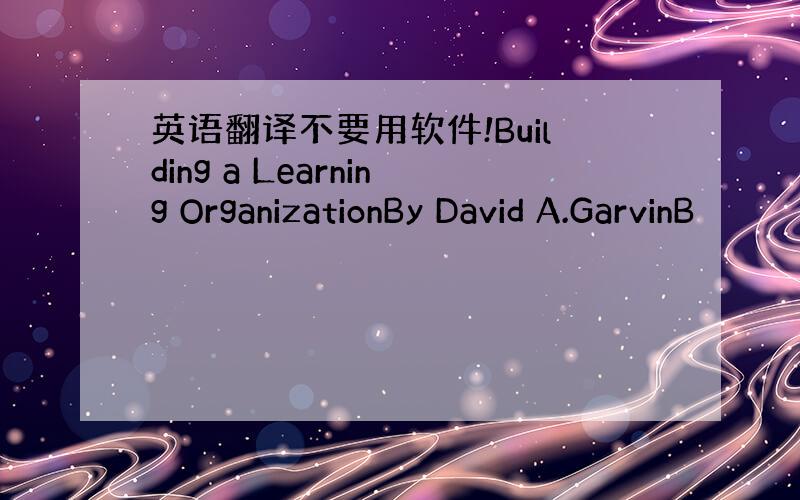英语翻译不要用软件!Building a Learning OrganizationBy David A.GarvinB
来源:学生作业帮 编辑:神马作文网作业帮 分类:英语作业 时间:2024/11/19 19:54:18
英语翻译
不要用软件!
Building a Learning Organization
By David A.Garvin
Beyond high philosophy and grand themes lie the gritty details of practice.
Continuous improvement programs are sprouting up all over as organizations strive to better themselves and gain an edge.The topic list is long and varied,and sometimes it seems as though a program a month is needed just to keep up.Unfortunately,failed programs far outnumber successes,and improvement rates remain distressingly low.Why?Because most companies have failed to grasp a basic truth.Continuous improvement requires a commitment to learning.
How,after all,can an organization improve without first learning something new?Solving a problem,introducing a product,and reengineering a process all require seeing the world in a new light and acting accordingly.In the absence of learning,companies— and individuals—simply repeat old practices.Change remains cosmetic,and improvements are either fortuitous or short-lived.
A few farsighted executives – Ray Stata of Analog Devices,Gordon Forward of Chaparral Steel,Paul Allaire of Xerox—have recognized the link between learning and continuous improvement and have begun to refocus their companies around it.Scholars too have jumped on the bandwagon,beating the drum for "learning organizations" and "knowledge-creating companies." In rapidly changing businesses like semiconductors and consumer electronics,these ideas are fast taking hold.Yet despite the encouraging signs,the topic in large part remains murky,confused,and difficult to penetrate.
Meaning,Management,and Measurement
Scholars are partly to blame.Their discussions of learning organizations have often been reverential and utopian,filled with near mystical terminology.Paradise,they would have you believe,is just around the corner.Peter Senge,who popularized learning organizations in his book The Fifth Discipline,described them as places "where people continually expand their capacity to create the results they truly desire,where new and expansive patterns of thinking are nurtured,where collective aspiration is set free,and where people are continually learning how to learn together."' To achieve these ends,Senge suggested the use of five "component technologies":systems thinking,personal mastery,mental models,shared vision,and team learning.In a similar spirit,Ikujiro Nonaka characterized knowledge-creating companies as places where "inventing new knowledge is not a specialized activity..,it is a way of behaving,indeed,a way of being,in which everyone is a
不要用软件!
Building a Learning Organization
By David A.Garvin
Beyond high philosophy and grand themes lie the gritty details of practice.
Continuous improvement programs are sprouting up all over as organizations strive to better themselves and gain an edge.The topic list is long and varied,and sometimes it seems as though a program a month is needed just to keep up.Unfortunately,failed programs far outnumber successes,and improvement rates remain distressingly low.Why?Because most companies have failed to grasp a basic truth.Continuous improvement requires a commitment to learning.
How,after all,can an organization improve without first learning something new?Solving a problem,introducing a product,and reengineering a process all require seeing the world in a new light and acting accordingly.In the absence of learning,companies— and individuals—simply repeat old practices.Change remains cosmetic,and improvements are either fortuitous or short-lived.
A few farsighted executives – Ray Stata of Analog Devices,Gordon Forward of Chaparral Steel,Paul Allaire of Xerox—have recognized the link between learning and continuous improvement and have begun to refocus their companies around it.Scholars too have jumped on the bandwagon,beating the drum for "learning organizations" and "knowledge-creating companies." In rapidly changing businesses like semiconductors and consumer electronics,these ideas are fast taking hold.Yet despite the encouraging signs,the topic in large part remains murky,confused,and difficult to penetrate.
Meaning,Management,and Measurement
Scholars are partly to blame.Their discussions of learning organizations have often been reverential and utopian,filled with near mystical terminology.Paradise,they would have you believe,is just around the corner.Peter Senge,who popularized learning organizations in his book The Fifth Discipline,described them as places "where people continually expand their capacity to create the results they truly desire,where new and expansive patterns of thinking are nurtured,where collective aspiration is set free,and where people are continually learning how to learn together."' To achieve these ends,Senge suggested the use of five "component technologies":systems thinking,personal mastery,mental models,shared vision,and team learning.In a similar spirit,Ikujiro Nonaka characterized knowledge-creating companies as places where "inventing new knowledge is not a specialized activity..,it is a way of behaving,indeed,a way of being,in which everyone is a

构建学习型组织 大卫 加维著
实践坚韧的痕迹往往高于深邃的哲学与主旋律.
组织若期望超越自我,革新才会持续不断的萌发.这个系列话题是冗长而多变的,而有时候就好像一个计划要耗掉一个月.不幸的是,失败的次数超过了成功,改善速率非常低,让人沮丧.为什么呢?因为多数的企业都没有抓住住一个基本的真理——持续的进步来自于对学习的保证.
那么究竟怎么样才能让一个组织取得进步而不比学习新的东西呢?解决问题、引进新产品、重新规划生产工序,这些都需要以一种新的眼光来看世界、采取行动.没有学习,企业或者个人都只是在重复老的实践活动.改变可能会伪装,而改进或是偶然,或是转瞬即逝.
一些有远见的执行官——Analog设备的Ray Stata,Chaparral钢铁的Gordon Forward,施乐复印机的Paul Allaire,都肯定了学习与持续进步之间的联系,同时他们都已开始关注企业在此方面的作为.学者们也赶上了潮流,鼓吹“学习组织”、“知识创造性企业”.迅速变化的商业就像半导体与消费电子学一样,这些理念立即就被接受了.然而出去积极的记号,很大程度上关注点都是黑暗的、迷惑的、难以参透的.
内涵、管理与方法
学者们应该负一些责任.他们有关于学习组织的讨论通常是高尚的、理想化的,充满了神秘的术语.他们会让你相信,天堂,其实就萦绕在你的身边.Peter Senge,在他的书《第五条纪律》中将学习组织发扬光大,他将其描述为在那里人们可以继续挖掘潜能来创造他们真正想要的结果.未来达到这些结论,他建议我们充分利用五个组成技术:系统思考、个人掌握、智力模型、观点分享、团队学习.简单而言,
实践坚韧的痕迹往往高于深邃的哲学与主旋律.
组织若期望超越自我,革新才会持续不断的萌发.这个系列话题是冗长而多变的,而有时候就好像一个计划要耗掉一个月.不幸的是,失败的次数超过了成功,改善速率非常低,让人沮丧.为什么呢?因为多数的企业都没有抓住住一个基本的真理——持续的进步来自于对学习的保证.
那么究竟怎么样才能让一个组织取得进步而不比学习新的东西呢?解决问题、引进新产品、重新规划生产工序,这些都需要以一种新的眼光来看世界、采取行动.没有学习,企业或者个人都只是在重复老的实践活动.改变可能会伪装,而改进或是偶然,或是转瞬即逝.
一些有远见的执行官——Analog设备的Ray Stata,Chaparral钢铁的Gordon Forward,施乐复印机的Paul Allaire,都肯定了学习与持续进步之间的联系,同时他们都已开始关注企业在此方面的作为.学者们也赶上了潮流,鼓吹“学习组织”、“知识创造性企业”.迅速变化的商业就像半导体与消费电子学一样,这些理念立即就被接受了.然而出去积极的记号,很大程度上关注点都是黑暗的、迷惑的、难以参透的.
内涵、管理与方法
学者们应该负一些责任.他们有关于学习组织的讨论通常是高尚的、理想化的,充满了神秘的术语.他们会让你相信,天堂,其实就萦绕在你的身边.Peter Senge,在他的书《第五条纪律》中将学习组织发扬光大,他将其描述为在那里人们可以继续挖掘潜能来创造他们真正想要的结果.未来达到这些结论,他建议我们充分利用五个组成技术:系统思考、个人掌握、智力模型、观点分享、团队学习.简单而言,
求英语翻译; Learning English is like building a house
英语翻译Building a Good Home Learning Environment.Home can be a
英语翻译To kiss your mouth deserves a haleluyah 请不要直接用翻译软件
英语翻译请不要用翻译软件The auction roomIn an auction,the price of a pro
翻译文章Building a Good Home Learning Environment. Home can be a
英语翻译英语翻译 不要软件翻译A birthday is a day when a person celebrates
英语翻译Learning and MemoryBackground.Learning involves "a chang
英语翻译翻译的句子通顺,不要太意译,A study of English learning problems was c
英语翻译不要网上在线翻译的,learning a foreign language is inseparable fro
英语翻译不要用翻译软件
英语翻译不要用翻译软件,
英语翻译不要用翻译软件.